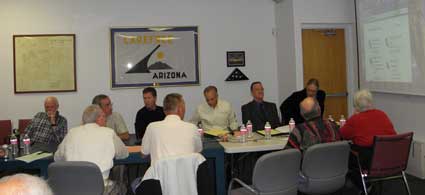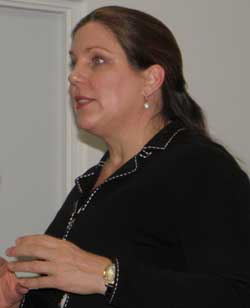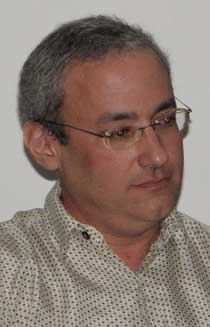BY LINDA BENTLEY | JANUARY 26, 2011
DAS workshop enlightens, frustrates town officials and citizens
 The joint work study session for Carefree Town Council and the planning commission on distributed antenna systems left officials, staff and citizens better informed, although somewhat frustrated by what appears to be a limited ability to address citizens’ concerns. Photos by Linda Bentley
The joint work study session for Carefree Town Council and the planning commission on distributed antenna systems left officials, staff and citizens better informed, although somewhat frustrated by what appears to be a limited ability to address citizens’ concerns. Photos by Linda Bentley
 CAREFREE – Catherine Malone (r), an independent expert in the field, presented an overview to council, planning commission members and interested citizens on the technical side of distributed antenna systems (DAS), while Attorney Kenneth Brunetti appeared telephonically to provide legal expertise.
CAREFREE – Catherine Malone (r), an independent expert in the field, presented an overview to council, planning commission members and interested citizens on the technical side of distributed antenna systems (DAS), while Attorney Kenneth Brunetti appeared telephonically to provide legal expertise.
Malone explained DAS was developed to reduce the need for such large antenna towers in certain situations and allow for smaller sites with less equipment that could be shared by multiple carriers.
She said DAS is not a substitute but rather a fill-in or complement to existing wireless networks.
According to Malone, because DAS is more expensive, it is generally installed in high density areas, areas where aesthetics are a concern and areas with varied terrain. It also requires fiber optics, which is not available in some areas.
Malone emphasized DAS is not a stand-alone substitute for traditional wireless networks.
Malone also made it clear she could talk about signal strength and the limits set by the FCC but she was not qualified to discuss health issues associated with RF (radio frequency) transmissions and stated the exposure levels set by the FCC are at 1/20 of what is considered a safe level.
She also explained that RF radiation is non-ionizing and does not break apart molecular bonds and that the RF spectrum used for wireless technology was a lower power than TV and radio transmission.
Malone displayed a chart showing a comparison of typical exposure levels from various RF/Microwave sources.
On a chart that showed cellular phones with the highest exposure on the left at 250 microwatts, it then dropped significantly as it moved to the right with a Bluetooth headset at 100, a CB radio at 30, a microwave oven at 20, a WiFi laptop at 15 and a baby monitor at 1, which was the same maximum public exposure from a DAS transmission site.
The far right side of the chart showed the typical DAS public exposure in a neighborhood at 0.1 microwatts.
As technology changes there has been more demand for wireless services using more bandwidth for internet, data and streaming video, for example, than just wireless phone calls.
So, as Malone explained, there are two factors, coverage and capacity, which are both necessary to provide the services newer technology demands.
Brunetti said there were basically two federal laws regulating wireless communication service, USC 47 C 332 and 253, which states: “In general no state or local statute or regulation, or other state or local legal requirement, may prohibit or have the effect of prohibiting the ability of any entity to provide any interstate or intrastate telecommunications service.”
The Telecommunications Act of 1996 was the first overhaul of telecommunications law in over 60 years and was initially passed with the goal of breaking up the “Ma Bell” monopolies by allowing anyone to enter into any communications business and let any communications business compete in any market against any other.
Basically, Brunetti said municipalities could not pass zoning ordinances that are considered unreasonable or that would effectively prohibit a carrier from providing service.
 When Planning Commissioner Marty Saltzman (l) asked what kind of restrictions a municipality could place on such installations, Brunetti said they could address aesthetics and placement of facilities. However, he said municipalities cannot prohibit or have the effect of prohibiting installations.
When Planning Commissioner Marty Saltzman (l) asked what kind of restrictions a municipality could place on such installations, Brunetti said they could address aesthetics and placement of facilities. However, he said municipalities cannot prohibit or have the effect of prohibiting installations.
In response to another one of Saltzman’s question, Brunetti said bonding is a reasonable zoning requirement.
Councilman Bob Coady asked if the town could request, under conditions of approval, that the company will agree its installation will not produce harmful health effects.
Brunetti said the town could try to get the company to agree to such a request but stated the company could not be required to do so.
Because RF limits are regulated by the federal government, the company only needs to guarantee it will not exceed those limits.
Brunetti said, “You can ask for anything, but seeing as that they have challenged everything [in court]” he recommended against it.
Saltzman queried, “Can we ask that the system automatically shut down if the system exceeds the guidelines?”
Brunetti said that was closer to something they could ask but stated, “You’re attempting to regulate environmental effects regulated by the federal government. And, the federal government says you cannot regulate safety issues at all.”
Councilman Peter Koteas said he read the Federal Communications Act in its entirety and asked, “Who decides who is ‘underserved?’ and that we lose all our rights. What’s up with that?”
Brunetti responded by saying the purpose of the Act was to break up wire line monopolies but stated it has “morphed into something very expansive.”
Koteas said it was very frustrating, citing the town wants to do the right thing for everyone, including the applicant, adding, from what he’s read, “We’re screwed.”
Councilman Doug Stavoe asked how the town could protect itself in the future if another company wanted to come in and do its own installation of DAS or if new technology came along, virtually doubling the number of antennas in an area.
Brunetti said he raised a good point and stated the town can limit the number of antennas in an area but it can’t discriminate against providers.
According to Brunetti, the question not directly addressed by the courts is if municipalities have to allow installations in rights of way.
Councilman Bob Gemmill encouraged anyone who had not yet seen the faux cactus antenna installation near the sundial to look at it, stating, “It’s very impressive.”
In summary, Brunetti stated, “You can regulate height, location and number of towers as long as you don’t regulate them so far as to prohibit them.”
During questions from the public, when Gary Zalimeni asked if he would consider this an industry plagued with lawsuits, Brunetti responded, “Yes,” noting NextG, one of the major DAS service providers, has been involved in dozens of lawsuits.




